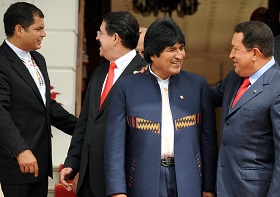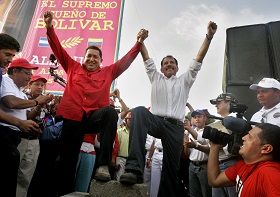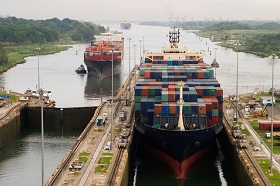Russia and Nicaragua: Together Again?
Vladimir Putin and Daniel Ortega in
Nicaragua, 2014.
In
Login if you are already registered
(no votes) |
(0 votes) |
PhD in Political Science, Research Associate at the Center for Political Studies, RAS Institute of Latin America
Vladimir Putin’s Latin American tour last July deserved the large amount of attention it received, among other things because of the last-minute change of itinerary to include a stop over in Nicaragua. The mystery of the schedule alteration was only later solved by the fact that there had been an earlier invitation from Daniel Ortega. In all, the visit was quite productive judging by the documents signed.
Vladimir Putin’s Latin American tour last July deserved the large amount of attention it received, among other things because of the last-minute change of itinerary to include a stop over in Nicaragua. The mystery of the schedule alteration was only later solved by the fact that there had been an earlier invitation from Daniel Ortega. In all, the visit was quite productive judging by the documents signed.
The Post-Conflict Syndrome
Nicaragua is still one of the poorest countries in the subcontinent as a segment of between 42 and 67 percent of its population lives barely over the poverty line, some 20 percent do not have electricity and 15 percent are deprived of fresh water supply. Social inequality is also running high, the Gini Index holding at a meager 51.2 percent, according to 2011 data from the Inter-American Development Bank [1]. In 2008, the richest ten percent of the population controlled 45 percent of the nation’s total revenue, whereas the poorest ten percent sufficed with just 1.4 percent.
Nicaragua still must overcome the consequences of the 1979 revolution which took the lives of thousands as well as the decade-long domestic armed conflict which placed the country on the Cold War map. The current elite is known to widely include former field commanders, the founders of the Sandinista National Liberation Front [2], led by Daniel Ortega who is currently running for his third presidential term.
Nicaragua still must overcome the consequences of the 1979 revolution which took the lives of thousands as well as the decade-long domestic armed conflict which placed the country on the Cold War map.
This turbulent decade of the past has predictably affected the domestic environment today. According to the UN Office on Drugs and Crime, premeditated murders in Nicaragua are happening at a rate of 11.3 per 100,000 (2012) [3] , the lowest in Central America, no matter how strange it might seem, with Honduras witnessing 90 and El Salvador 41 murders, respectively [4]. Interestingly, the violence has decreased in the absence of the mano dura practices widely used by the Somoza regime [5].
Many believe the reason lies in Nicaragua's avoidance of the drugs war futilely waged by the United States on the American continent. If so, a surge in violence appears to be just a matter of time.
Neighborly Policies
As cleverly noted by the U.S. magazine Foreign Policy, Mr. Ortega's rule can be defined as Orteganomics, since the president skillfully combines authoritarianism in politics, support to business in economy and populism in social matters marked by overall pragmatism [6]. This definition also reflects the balance of Managua's priorities in international trade and foreign policy.

The Presidents of Venezuela, Ecuador,
Nicaragua, Bolivia and Honduras at the meeting
on crisis resolution, 2008.
First of all, Nicaragua is very active in the processes of integration occurring on the subcontinent, being among the initiators of the Central American Common Market (CACM) [7]. It is not an accident that the other members of this organization are among the top ten partners for Nicaraguan exports and imports, trailing only U.S.A. and Mexico on the list [8].
Venezuela is Mr. Ortega's special foreign policy priority. Along with close ideological affinities (he joined the Bolivarian Alternative for America – ALBA [9] on his second day in office [10] ), the rapprochement has also had economic motivations. Caracas appears to be the most attractive partner in view of helping to solve the perennial problems in the Nicaraguan energy sector, which still fails to meet the growing rural and industrial demand [11].
After Nicaragua joined ALBA, bilateral trade with Venezuela skyrocketed. Notably, Nicaragua exports beef cattle, sugar, oils, coffee, dairy products and black beans, and imports oil and oil products. As a result, over the past several years, Venezuela has firmly held third place among the top importers of Nicaraguan goods and trails behind the CACM states on the list of its main exporters to Nicaragua [12]. Regrettably, because Hugo Chavez, the inventor, ideologue and promoter of the bloc died in 2013, it is still uncertain whether ALBA remains viable and can ensure intensive inter-state cooperation at the same previously high level.
Friendly with Strangers and a Stranger among Friends
Mr. Ortega's rule can be defined as Orteganomics.
Despite his regularly declared commitment to the Bolivarian interpretation of the 21st Century Socialism, Mr. Ortega has been cautious about anti-U.S. rhetoric, the calling card of the deceased Venezuelan leader. The reason seems to lie in his pragmatism, since the United States still is Nicaragua's key economic partner, both in terms of imports and exports, as well as the largest supplier of FDI [13].
Practicality must have pushed Mr. Ortega to search for partners beyond his region, which is an essential strategy in a globalized world. The top actors of this sort for Nicaragua are China and Iran, the latter scaling down its presence in Central America after the election of President Hassan Rouhani.
To a certain extent, Nicaragua and Iran became friendly because both closely cooperated with Venezuela. In addition, both had struggled against imperialism, their revolutions taking place the same year. Hence, in 2007, many regarded the restoration of diplomatic relations between Managua and Tehran after a 16-year gap as a sign that the mullah regime still viewed the Sandinistas as their natural allies.
By engaging the IRI, Nicaragua also proceeded from its need to solve its most pressing problems, primarily in energy, while Iran also hinted about investing in the construction of hydropower stations. Nevertheless, their cooperation does not seem to have brought any palpable results over the past five years.
In contrast to Iran, relations with China appear critical in view of Nicaragua’s drive to diversify its foreign trade. Noticeably, growing cooperation with Beijing in the absence of diplomatic relations between the two countries is taking place at the same time as mutually beneficial trade between Managua and Taipei. For example, Costa Rica has made its choice in favor of the world's third largest economy.
Checkbook Diplomacy
The top actors of this sort for Nicaragua are China and Iran.
China's economic expansion is the most visible trend of Latin American development at the dawn of the new millennium, while the Interoceanic Grand Canal (IGC) is the most discussed project that Chinese firms are planning to implement. The new passage will connect the Pacific and the Atlantic in order to unburden the Panama Canal, which is not capable of handling growing maritime traffic [14]. The international concession for the construction of the canal has been granted to the Hong Kong firm Nicaraguan Canal Development Investment Co Ltd, owned by Chinese billionaire Wang Jing, who has also been permitted to build deepwater ports on Nicaragua's Caribbean coast, an international airport, a tourist complex and an oil pipelinel the firm will also establish two free trade zones. The project is supervised by Laureano Ortega Murillo, the president's son. Interestingly, some sources insist that planning and survey works are to be financed personally by Mr. Wang [15].
If successful, the canal is sure to become the most ambitious infrastructure project in the region.
If successful, the canal is sure to become the most ambitious infrastructure project in the region, and have an immense impact on the inter-American balance of forces. Above all, it will vividly exemplify the potent presence of Chinese investors in Latin America's economy, highlighting the loss of American primacy over key decisions in the area of its traditional interests. In view of its overall decline in the Western Hemisphere, the White House hurriedly showed interest in the program. A public statement came from Deputy Assistant Secretary of Commerce Walter Bastian back in July 2013, when he stated that American private investors were somewhat interested, although he paid no heed to the geopolitical significance of the future canal [16].
In addition, relations between Washington and Managua are still overshadowed by the Cold War. Therefore, the White House is understandably jealous about new actors emerging close to U.S. borders. And the assertively advancing Russia appears to be among such countries.
From Russia with Love
Dominated by the "paternalist Soviet-Sandinista model" over the past several decades, relations between Russia and Nicaragua currently rest on a sense of mutual pragmatism without any ideological overtones. The 1990s, disastrous for the bilateral dialogue, were followed by the 2002 Treaty on Basic Bilateral Relations and the complete write-off of Soviet-era Nicaraguan debts [17].
Although cooperation has become fully market-oriented, bilateral trade is still very modest. According to the Russian Customs Service, in 2013 Nicaragua was Russia's 131st-largest partner in exports and the 110th in imports [18]. The much more significant potential for interaction appears to exist in other spheres, as several days ago President Putin signed a law ratifying the bilateral Agreement on Peaceful Space Research [19].
Upon news on Russia's possible participation in the IGC project, the international media exploded with stories about Moscow’s return to south of Rio Grande.
Upon news on Russia's possible participation in the IGC project, the international media exploded with stories about Moscow’s return to south of Rio Grande. Apparently, the canal’s financial issues will remain a Chinese concern, while Russia will focus on military-political matters, as observed by the bilateral agreement permitting Russian ships and aircraft to patrol Nicaraguan waters in the Pacific and the Caribbean until June 30, 2015 [20].
The emergence of Russian Air Force and Navy offshore in the Western Hemisphere is also a headache for Colombia, the U.S.’s closest ally in South America. Bogota is not pleased by the 2012 ruling by the International Court of Justice that redrew the Nicaragua-Colombia maritime border. A 2014 Nicaraguan statement that both Russian and American ships are allowed to cross its sector of the Caribbean has triggered new tensions in the protracted dispute [21].
Recently, contacts between Russia and Nicaragua made the news again, this time concerning the deployment of the ground station of the Russian GLONASS navigation system near Managua [22]. Tensions have heightened over reports about an agreement between Moscow and Havana to resume the operation of the signal intelligence facility near the Cuban capital, a base that was unilaterally shut down by Russia in 2001. However, these reports were soon officially disclaimed [23].
Forecasting in the fast changing international environment does not reap benefits. Nevertheless, Russia's interest in building up its long-term presence in Latin America is unbending. Only time will tell if Moscow's participation in the Central American megaproject will advance bilateral and multilateral ties in the Western Hemisphere.
1. Nicaragua: Gini Coefficient of per capita income http://www.iadb.org/es/investigacion-y-datos//vistazo-por-pais,6754.html
2. The Sandinista National Liberation Front is a radical leftist military-political organization that came to power through military struggle in 1979.
3. Intentional homicide count and rate per 100,000 population, by country/territory (2000-2012) http://www.unodc.org/gsh/en/data.html
4. Intentional homicide count and rate per 100,000 population, by country/territory (2000-2012) http://www.unodc.org/gsh/en/data.html
6. Looney Robert. Daniel Ortega’s Reality Check. http://www.foreignpolicy.com/articles/2013/01/10/daniel_ortegas_reality_check
7. The Central American Common Market (Mercado Común Centroamericano in Spanish) was established in 1960 by EL Salvador, Guatemala, Honduras and Costa Rica. The member states were about to form a customs union, but the soccer war between Honduras and El Salvador caused it to break down. The association was restored in 1991, after which the member states began lowering duties in order to stimulate mutual trade, although later the share of mutual trade in overall figures diminished. In the 2000s, the countries removed many barriers and formed a customs union, establishing a universal customs duty at 0-15 percent. The CACM also stepped up efforts to develop free trade areas with other countries, i.e. with the U.S.A. (CAFTA) and the Dominican Republic. In 2000, the Northern Triangle, i.e. El Salvador, Guatemala and Honduras, signed an agreement with Mexico. There are also bilateral free trade zones between Nicaragua and Mexico (1997) and Costa Rica and Mexico (1994).
8. Boletín Anual de Comercio Exterior y Acciones de Política Comercial de Nicaragua. Año 2013. www.mific.gob.ni
9. As named on the date of Nicaraguan entry, but since 2009 known as the Bolivarian Alliance for Americas
10. Documento de Adhesión de Nicaragua al ALBA http://sajurin.enriquebolanos.org/vega/docs/2007%20Documento%20de%20Adhesi
%C3%B3n%20de%20Nicaragua%20al%20ALBA.pdf11. Débil infraestructura eléctrica afecta al desarrollo de Nicaragua. El nuevo diario. 2006/06/21.
12. Boletín Anual de Comercio Exterior y Acciones de Política Comercial de Nicaragua. Año 2013. www.mific.gob.ni
13. Ibidem.
14. Yakovleva N.M. A Nicaraguan Canal to the Bright Future // Latin America journal. Issue 1, 2014. Pp. 34-37
15. El canal de Nicaragua y la transformación de América Latina. http://opinion.infobae.com/evan-ellis/2013/06/26/el-canal-de-nicaragua-y-la-transformacion-de-america-latina
16. Zuckerman, Jessica. Nicaragua’s Canal Push and Concerns for the U.S. http://www.heritage.org/research/reports/2013/08/nicaragua-s-canal-push-and-concerns-for-the-us
17. Nicaragua: Sandinistas back at the Helm. Moscow: RAS Institute for Latina American Studies, The Summit Series, 2008. Pp. 47-50
18. Trade and Economic Relations between Russia and Nicaragua. http://nic.ved.gov.ru/dvustoronnii_otnoshenija/obzor_torg
19. Federal Law of the Russian Federation No. 215-FZ of July 21, 2014 www.rg.ru/2014/07/23/nikaragua-dok.htmlv
20. www.nicaragua.polpred.com/
21. Hot waters. www.economist.com/blogs/americasview/2012/11/colombia-and-nicaragua
22. Ambassador: GLONASS Station to be Deployed in 1-2 Years. http://www.vz.ru/news/2014/7/19/696307.html?keepThis=true&TB_iframe=true&height
=500&width=1100&caption=%D0%92%D0%B7%D0%B3%D0%BB%D1%8F%D0%B423. Putin Denies Intelligence Center to be Restored in Cuba http://lenta.ru/news/2014/07/17/lurdes/
(no votes) |
(0 votes) |






